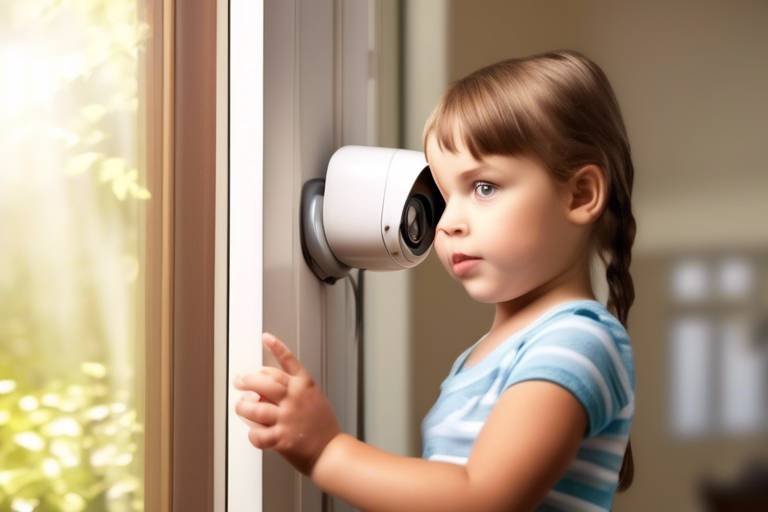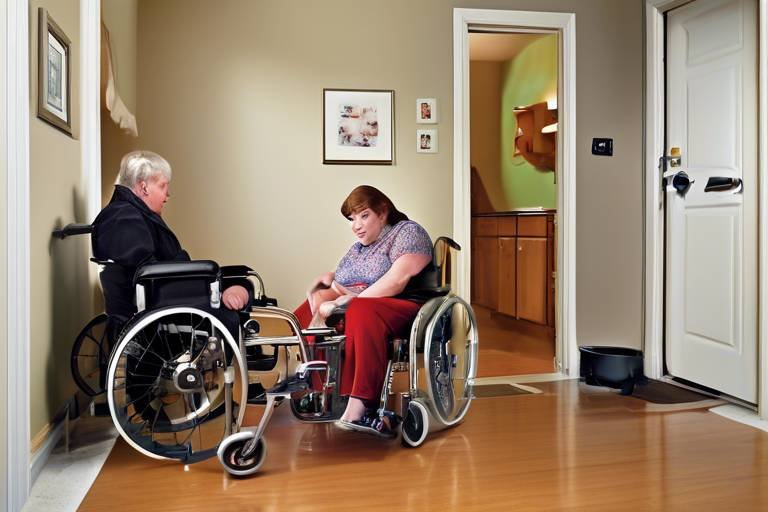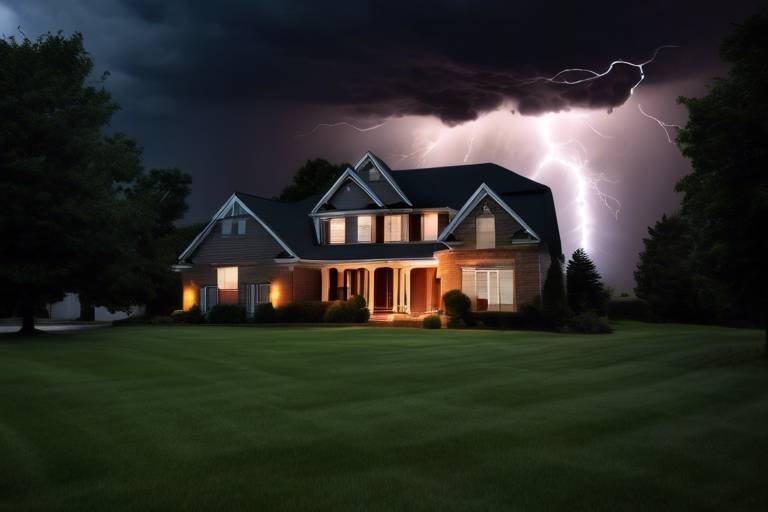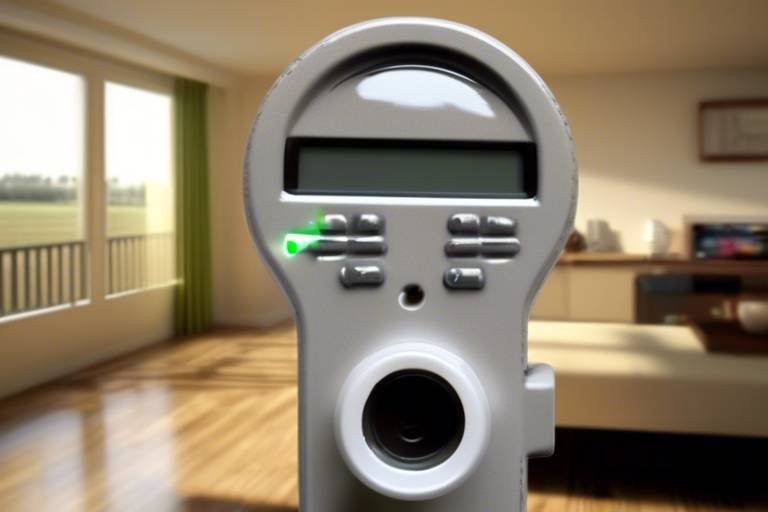Are Smart Home Devices Worth the Investment
In today's fast-paced world, the idea of turning your home into a smart haven is more than just a trend; it's becoming a lifestyle choice for many. But the big question remains: are smart home devices really worth the investment? With an array of gadgets that promise to make our lives easier, safer, and more efficient, it’s easy to get swept away by the excitement. However, before diving into the world of smart technology, it's essential to weigh the benefits against the costs and potential drawbacks.
Smart home devices have revolutionized the way we interact with our living spaces. Imagine being able to control your lights, thermostat, and security system all from your smartphone, whether you're lounging on the couch or halfway across the globe. This level of convenience is undeniably appealing. Yet, it’s crucial to consider whether these conveniences justify the initial financial outlay, ongoing maintenance, and potential compatibility issues with other devices.
When contemplating the investment in smart home technology, think of it as a long-term commitment. Just like buying a car or a new appliance, you need to assess not only the upfront costs but also the potential savings and improvements in your quality of life. For many, the allure of energy efficiency, enhanced security, and seamless automation can tip the scales in favor of making the leap into smart technology.
However, it's not all sunshine and rainbows. There are concerns about privacy, security vulnerabilities, and the complexity of managing multiple devices. What happens if your smart home system goes offline? Or if a security breach occurs? These are valid questions that every potential buyer should consider. It's essential to do thorough research and choose reputable brands that prioritize user security and offer reliable customer support.
In the sections that follow, we'll delve deeper into the various components of smart home technology, analyze the costs versus savings, and explore how these devices can enhance your lifestyle. By the end of this article, you will have a clearer picture of whether investing in smart home devices aligns with your lifestyle and budget.
- What are the most popular smart home devices? Smart speakers, smart thermostats, smart lighting, and security cameras are among the most commonly used devices.
- Do smart home devices really save money? Yes, many smart devices can lead to lower utility bills through energy efficiency, although the savings may vary.
- Are smart home devices secure? While they can be vulnerable to hacking, using strong passwords and keeping firmware updated can enhance security.
- Can I install smart home devices myself? Many smart devices are designed for easy installation, but some may require professional help.

Understanding Smart Home Technology
This article explores the benefits and drawbacks of smart home devices, helping readers decide if the investment is worthwhile for their lifestyle and budget.
Smart home technology is revolutionizing the way we live, making our homes not just shelters, but interactive environments that cater to our needs. Imagine walking into your home, and the lights automatically adjust to your preferred brightness, the thermostat sets the perfect temperature, and your favorite playlist starts playing—all without lifting a finger. This is the magic of smart home technology! But what exactly does it entail?
At its core, smart home technology comprises a network of devices connected through the internet, allowing them to communicate with each other and be controlled remotely. These devices can range from smart speakers and thermostats to security cameras and lighting systems. Each device typically connects to a central hub or can be controlled via a smartphone app, making it easy to manage your home from anywhere.
Here’s a quick breakdown of some common components of smart home technology:
- Smart Hubs: Devices like Amazon Echo or Google Nest Hub serve as the central control unit for your smart home.
- Smart Sensors: These include motion detectors and door/window sensors that enhance security and automate routines.
- Smart Appliances: From refrigerators to washing machines, these appliances can be controlled remotely, providing convenience and efficiency.
As you delve deeper into the world of smart home technology, you'll find that the variety of devices available is staggering. They can be categorized into several types:
| Device Type | Functionality |
|---|---|
| Smart Lighting | Control brightness and color remotely; set schedules. |
| Smart Thermostats | Optimize heating and cooling based on your habits. |
| Smart Security Systems | Monitor your home with cameras and alarms; control locks. |
| Smart Appliances | Manage tasks like cooking and cleaning from your phone. |
In essence, smart home technology is about creating an ecosystem that works seamlessly together to enhance your living experience. It’s like having a personal assistant who anticipates your needs and adapts to your lifestyle. However, while the convenience and efficiency are appealing, it's essential to consider the initial investment and ongoing costs associated with these devices.
Ultimately, understanding smart home technology is the first step in determining whether these devices can genuinely enhance your life. As you explore the possibilities, think about how these innovations can align with your daily routines. Are you ready to embrace a smarter way of living?
A detailed examination of the initial costs versus long-term savings associated with smart home devices, including energy efficiency and potential increases in property value.
Exploring how smart home devices contribute to energy efficiency, leading to lower utility bills and a reduced carbon footprint for environmentally conscious consumers.
An analysis of smart thermostats, their features, and how they can optimize heating and cooling systems for maximum efficiency and comfort.
A look at smart lighting options, including their benefits in energy savings, convenience, and the ability to create customizable lighting environments.
Discussing how smart home devices simplify daily routines, enhance convenience, and improve overall quality of life for users.
An exploration of the security benefits that smart home devices offer, including surveillance cameras, smart locks, and alarm systems.
A review of various smart surveillance systems available, their features, and how they enhance home security and provide peace of mind.
An overview of smart locks, focusing on their convenience, security features, and the ability to control access remotely.
Q: What are the main benefits of smart home devices?
A: Smart home devices offer convenience, energy efficiency, enhanced security, and the ability to automate daily tasks.
Q: Are smart home devices expensive?
A: While the initial costs can be high, many devices lead to long-term savings on energy bills and can increase property value.
Q: How secure are smart home devices?
A: Most smart home devices come with robust security features, but it's essential to keep software updated and use strong passwords.

Cost Analysis of Smart Home Devices
When considering the investment in smart home devices, it's crucial to look beyond the initial sticker price. Sure, that smart thermostat might make your jaw drop when you see the price tag, but what about the long-term benefits? In this section, we’ll dive deep into the financial implications of these gadgets, comparing the upfront costs with the potential savings they can offer over time.
First off, let's break down the initial costs of smart home technology. Depending on the type of devices you're looking at, prices can vary widely. For instance, a basic smart thermostat can range from $100 to $250, while a comprehensive smart lighting system might set you back several hundred dollars. Here’s a quick comparison of some popular smart home devices and their average costs:
| Device Type | Average Cost |
|---|---|
| Smart Thermostat | $100 - $250 |
| Smart Lighting (per bulb) | $10 - $50 |
| Smart Lock | $150 - $300 |
| Smart Security Camera | $100 - $300 |
Now, while these figures might seem daunting, consider the long-term savings that can offset these initial expenses. Smart home devices are designed to enhance energy efficiency, which can lead to significant reductions in utility bills. For example, smart thermostats can learn your schedule and adjust temperatures accordingly, potentially saving you up to 15% on heating and cooling costs. That’s not just a few bucks; over the course of a year, those savings can add up!
But wait, the benefits don’t stop there! Many smart devices can also increase your home's value. According to a recent study, homes equipped with smart technology tend to sell for about 5% more than their traditional counterparts. So, if you're planning to sell your home in the future, installing smart devices could be a wise investment that pays off when it’s time to list.
As we mentioned earlier, energy efficiency is a major selling point for smart home devices. Not only do these gadgets help you save money, but they also contribute to a greener planet. By reducing energy consumption, you’re not only lowering your bills but also your carbon footprint. It’s like hitting two birds with one stone! Plus, many utility companies offer rebates for energy-efficient devices, which can further offset your costs.
Smart thermostats are a prime example of how technology can optimize your home’s energy usage. They can analyze your heating and cooling patterns and adjust settings automatically. Imagine arriving home to a perfectly cozy house without having to fiddle with the thermostat! Some models even allow you to control the temperature from your smartphone, giving you the power to adjust settings while you're away. This convenience translates to energy savings, making them a worthwhile investment.
Smart lighting solutions offer another layer of savings. With features like scheduling and remote control, you can ensure that lights are only on when needed. Think about it: how often do you leave a room and forget to turn off the lights? With smart bulbs, you can control everything from your phone or set them to turn off automatically. Additionally, many smart bulbs use LED technology, which is inherently more energy-efficient than traditional lighting options.
In conclusion, while the upfront costs of smart home devices may seem high, the potential for long-term savings and increased property value makes them a worthy consideration. Whether it's through reduced energy bills or enhanced home security, investing in smart technology can lead to a more comfortable, efficient, and secure living environment.
- Are smart home devices easy to install? - Many devices are designed for easy DIY installation, while others may require professional help.
- Do smart home devices work without Wi-Fi? - Most smart devices require a stable Wi-Fi connection to function properly.
- Can I control smart devices remotely? - Yes, most smart home devices can be controlled via apps on your smartphone.

Energy Efficiency and Savings
When it comes to smart home devices, one of the most compelling arguments for their adoption is their potential for energy efficiency and the subsequent savings they can provide. Imagine walking into your home and having your smart thermostat automatically adjust the temperature based on your preferences and the weather outside. This isn't just a luxury; it's a smart way to save money on your energy bills while keeping your home comfortable.
Smart home devices are designed to work together seamlessly, creating a network that optimizes energy usage. For instance, smart thermostats can learn your habits over time, adjusting the heating and cooling systems to match your schedule. This means no more heating an empty house or cooling down a space that no one is using. In fact, studies show that homeowners can save up to 30% on heating and cooling costs with these devices. But that's just the tip of the iceberg!
Let's not forget about smart lighting solutions. Traditional lighting can consume a significant amount of energy, especially when lights are left on when no one is around. Smart lights, however, can be programmed to turn off automatically when you leave a room or dim when natural light is sufficient. This not only enhances your home’s ambiance but also contributes to lower energy bills. By switching to LED smart bulbs, you can save up to 80% more energy compared to traditional incandescent bulbs. The combination of these smart technologies can lead to substantial savings over time.
| Device Type | Potential Savings | Energy Efficiency Benefits |
|---|---|---|
| Smart Thermostats | Up to 30% | Optimizes heating/cooling based on usage patterns |
| Smart Lighting | Up to 80% | Automatically turns off/dims when not in use |
| Smart Plugs | Varies | Monitors energy usage and schedules devices to reduce consumption |
By investing in smart home technology, you're not just enhancing your lifestyle—you're also making a commitment to environmental sustainability. Lower energy consumption means a reduced carbon footprint, which is increasingly important in our fight against climate change. Consumers today are more conscious than ever about their environmental impact, and smart devices offer a practical way to contribute positively.
Additionally, many utility companies offer incentives and rebates for homeowners who install energy-efficient devices. This can further offset the initial costs of these technologies, making them even more attractive. So, if you're on the fence about whether to invest in smart home devices, consider the long-term savings and environmental benefits they can provide.
In conclusion, while the upfront cost of smart home devices may seem daunting, the potential for energy savings and efficiency makes them a worthwhile investment. Not only do they help you save money on monthly utility bills, but they also enhance your home’s comfort and contribute to a more sustainable future. Isn’t it time to embrace the future of home living?
- What are smart home devices? Smart home devices are internet-enabled gadgets that allow you to control various aspects of your home, such as lighting, temperature, and security, from your smartphone or other devices.
- How much can I save with smart home devices? Savings can vary widely, but many users report reductions of 20-30% on their energy bills with smart thermostats and up to 80% with smart lighting solutions.
- Are smart home devices secure? While there are concerns about security, most reputable smart home devices come with robust security features to protect your data and privacy.
- Do I need a smart home hub? Not necessarily! Many smart devices can operate independently or through apps, but a hub can enhance compatibility and control.

Smart Thermostats
Smart thermostats are revolutionizing the way we manage our home heating and cooling systems. Imagine being able to control the temperature of your home from anywhere in the world, all from the palm of your hand. With a smart thermostat, this is not just a dream; it’s a reality! These devices learn your habits, preferences, and even the weather outside to optimize your home's climate for maximum comfort and efficiency.
One of the standout features of smart thermostats is their ability to adapt to your lifestyle. For instance, they can detect when you’re home or away and adjust the temperature accordingly. This means no more heating or cooling an empty house, which can lead to significant savings on your energy bills. In fact, studies have shown that smart thermostats can save homeowners anywhere from 10% to 30% on their heating and cooling costs each year.
Let’s break down some of the key features that make smart thermostats a worthy investment:
- Remote Access: Control your thermostat from your smartphone, tablet, or laptop. This is especially useful for those unexpected changes in plans or if you forget to adjust the temperature before leaving home.
- Energy Reports: Many smart thermostats provide detailed energy usage reports, helping you understand your consumption patterns and find ways to save even more.
- Integration with Smart Home Systems: These devices often work seamlessly with other smart home gadgets, allowing for a fully integrated smart home experience. Imagine your thermostat adjusting automatically when you arrive home, thanks to your smart lock unlocking your door!
When considering a smart thermostat, it’s also essential to look at compatibility with your existing HVAC system. Most modern systems will work with smart thermostats, but older systems may require additional equipment or may not be compatible at all. Therefore, it’s a good idea to consult with a professional or check the manufacturer's specifications before making a purchase.
In summary, smart thermostats not only enhance your comfort but also contribute to energy efficiency and savings. With their advanced features and user-friendly interfaces, they represent a smart choice for anyone looking to upgrade their home technology. So, if you’re still adjusting your thermostat manually, it might be time to consider making the switch!
Q: Can I install a smart thermostat myself?
A: Yes, many smart thermostats are designed for easy DIY installation. However, if you're not comfortable with electrical work, hiring a professional is advisable.
Q: Will a smart thermostat work with my existing heating and cooling system?
A: Most smart thermostats are compatible with a wide range of HVAC systems, but it's best to check compatibility before purchasing.
Q: How much can I really save on my energy bills?
A: Savings can vary, but many users report reductions of 10% to 30% on their heating and cooling costs after installing a smart thermostat.

Smart Lighting Solutions
When it comes to transforming your home into a smart haven, are often the first step many homeowners take. Imagine being able to control the ambiance of your home with just a tap on your smartphone or a simple voice command. It’s like having your own personal lighting assistant! These innovative devices offer more than just convenience; they can significantly enhance your living space while saving energy and reducing costs.
Smart lighting solutions come in various forms, from smart bulbs that can change colors to smart switches that allow for remote control of your existing fixtures. The beauty of these devices lies in their versatility. You can customize your lighting to match your mood, whether you’re hosting a lively dinner party or winding down after a long day. With the ability to adjust brightness and color temperatures, you can create the perfect atmosphere for any occasion.
One of the standout features of smart lighting is its ability to integrate with other smart home devices. For instance, you can set your lights to automatically turn on when your smart lock is disengaged, welcoming you home with a warm glow. Or, you could program your lights to dim when you start a movie, transforming your living room into a cozy theater. The possibilities are endless!
Moreover, let’s talk about energy efficiency. Smart lighting solutions are designed to use LED technology, which consumes significantly less energy than traditional incandescent bulbs. This means not only are you reducing your carbon footprint, but you're also saving money on your electricity bills. In fact, according to a study by the Department of Energy, switching to LED bulbs can save you up to 75% in energy costs over time. That’s a smart investment!
To give you a clearer picture of the savings, here’s a quick comparison:
| Type of Bulb | Average Lifespan (hours) | Annual Energy Cost (based on 3 hours/day usage) |
|---|---|---|
| Incandescent | 1,000 | $11.00 |
| CFL | 10,000 | $4.00 |
| LED | 25,000 | $1.00 |
As you can see, the long-term benefits of switching to smart lighting solutions are hard to ignore. Not only do they save you money, but they also enhance your quality of life. You can schedule your lights to turn on and off at specific times, which adds an extra layer of security to your home. It’s like having a friendly presence at home, even when you’re away!
In conclusion, investing in smart lighting solutions is more than just a trend; it’s a way to make your home smarter, more energy-efficient, and tailored to your lifestyle. So, are you ready to light up your life with smart technology?

Convenience and Lifestyle Enhancement
In today's fast-paced world, convenience is king. Smart home devices are like personal assistants, tirelessly working behind the scenes to make our lives easier. Imagine waking up in the morning to the gentle glow of your smart lights gradually brightening, simulating a natural sunrise. This simple yet effective feature can help you start your day on a positive note, without the jarring sound of an alarm clock. Isn't that a dream come true?
Furthermore, the integration of smart home devices can streamline daily routines in ways that were once the stuff of science fiction. Picture this: you’re on your way home from work, and with just a tap on your smartphone, your smart thermostat adjusts the temperature to your liking, while your smart coffee maker brews your favorite blend. By the time you walk through the door, your home is not only comfortable but also welcoming. This level of automation transforms mundane tasks into seamless experiences.
Moreover, smart home devices offer customizable settings that cater to individual lifestyles. For instance, families can set different lighting scenes for movie nights, dinner parties, or even a cozy reading nook. The ability to personalize your environment enhances comfort and fosters a sense of belonging. You can even create schedules or routines that reflect your unique lifestyle. Want your lights to dim at bedtime? Or perhaps you prefer the coffee maker to start brewing as soon as you wake up? The possibilities are endless!
Another significant advantage is the integration of voice control through smart speakers. With a simple voice command, you can control various devices without lifting a finger. Imagine cooking in the kitchen and asking your voice assistant to play your favorite playlist or adjust the thermostat while your hands are full. This hands-free convenience is not just a luxury; it’s a game-changer for multitaskers and busy households.
In addition to enhancing convenience, smart home technology can also bolster safety and security. For example, smart doorbells with integrated cameras allow homeowners to see and communicate with visitors remotely. You can check who’s at your door while you’re still in your pajamas or even while you’re miles away on vacation. This peace of mind is invaluable, especially for those who travel frequently or have young children at home.
To summarize, smart home devices are not just about flashy technology; they are about improving your quality of life. By automating mundane tasks, providing personalized experiences, and enhancing security, these devices can truly transform your living space into a haven of comfort and convenience. So, are you ready to embrace the future of home living?
- What are smart home devices? Smart home devices are electronic devices that connect to the internet and can be controlled remotely, allowing for automation and enhanced control over various aspects of your home.
- How do smart home devices improve convenience? They automate daily tasks, such as adjusting lighting, controlling temperature, and managing security systems, making life easier and more efficient.
- Are smart home devices secure? While they offer enhanced security features, it's essential to choose reputable brands and secure your network to mitigate potential risks.
- Can I control smart home devices with my smartphone? Yes, most smart home devices can be controlled via dedicated smartphone apps, allowing for remote management and automation.

Security Features of Smart Home Devices
In today's fast-paced world, ensuring the safety of our homes is more important than ever. Smart home devices have emerged as a game-changer in this arena, offering innovative solutions that enhance security and provide peace of mind. From smart surveillance systems to advanced locks, these devices not only protect your property but also empower you with control and convenience. Imagine being able to monitor your home from anywhere in the world, receiving alerts if something seems amiss, or even unlocking your door for a friend while you're miles away. Sounds like a scene from a sci-fi movie, right? But this is the reality that smart technology brings to our lives.
At the heart of smart home security are devices designed to keep you informed and in control. Let’s break down some of the key features and benefits:
- Real-time Monitoring: Smart surveillance cameras allow you to monitor your home in real-time through your smartphone or tablet. You can check in on your property anytime, anywhere, giving you a sense of security that traditional systems simply can't match.
- Alerts and Notifications: Many smart security devices come equipped with motion sensors that send instant alerts to your device when unusual activity is detected. This feature ensures that you are always aware of what’s happening around your home.
- Remote Access: With smart locks and cameras, you can control access to your home remotely. Whether it's letting in a delivery person or checking on your pets, the convenience is unmatched.
Moreover, the integration of these devices into a cohesive smart home ecosystem enhances their effectiveness. For instance, a smart doorbell camera can be linked to your smart locks, allowing you to see who is at your door and grant access without having to be physically present. This interconnectedness not only simplifies your life but also fortifies your home's security.
When it comes to smart surveillance systems, the options are vast and varied. From indoor cameras that keep an eye on your pets to outdoor cameras that monitor your yard, these devices are designed with various features to suit your needs. Most modern cameras offer high-definition video, night vision, and two-way audio, which allows you to communicate with anyone on the other side. Some advanced models even utilize artificial intelligence to differentiate between family members, pets, and potential intruders, reducing false alarms and enhancing overall security.
Smart locks represent a significant leap forward in home security technology. Gone are the days of fumbling for keys or worrying about lost duplicates. With smart locks, you can use your smartphone to lock or unlock your door with just a tap. Many models also offer features like keyless entry, temporary access codes for guests, and activity logs that let you see who accessed your home and when. This level of control not only enhances convenience but also adds an extra layer of security.
In conclusion, the security features of smart home devices are not just about keeping intruders at bay; they are about empowering homeowners with the tools they need to feel safe and secure. As technology continues to evolve, investing in smart home security can provide peace of mind and a sense of control over your living environment.
Q1: Are smart home devices secure from hacking?
A1: While no device is completely immune to hacking, most smart home devices come with robust security features, such as encryption and regular software updates, to protect against vulnerabilities. It's essential to choose reputable brands and keep your devices updated.
Q2: Can I install smart security devices myself?
A2: Many smart home devices are designed for easy DIY installation, often requiring just a smartphone app and a few simple tools. However, for more complex systems, professional installation may be recommended.
Q3: How do smart home devices integrate with each other?
A3: Most smart home devices are designed to work within a specific ecosystem, such as Google Home or Amazon Alexa. This allows them to communicate with each other, providing a seamless user experience.
Q4: What if I lose internet connectivity?
A4: Many smart devices have offline capabilities and can continue to operate without internet access. However, remote monitoring features will be limited until the connection is restored.

Smart Surveillance Systems
When it comes to ensuring the safety of your home, have emerged as a game-changer. These devices not only provide a sense of security but also bring the power of technology right to your fingertips. Imagine being able to monitor your home from anywhere in the world, all through your smartphone! With features like real-time alerts, HD video streaming, and even night vision, smart surveillance systems are designed to give you peace of mind.
But how do these systems work? At their core, smart surveillance cameras connect to your home Wi-Fi network, allowing you to access live feeds and recorded footage from your mobile device. Some systems even integrate with other smart home devices, creating a cohesive security network that can be managed from a single app. This interconnectivity means you can set up alerts if motion is detected, lock your doors remotely, or even turn on lights to deter intruders, all with a simple tap on your phone.
Now, let’s break down some of the key features that make smart surveillance systems a worthy investment:
- Remote Monitoring: Access live video feeds and recordings from anywhere, giving you control over your home security.
- Two-Way Audio: Communicate with visitors or potential intruders through built-in speakers and microphones.
- Smart Notifications: Receive instant alerts on your phone when motion is detected or when someone approaches your door.
- Cloud Storage Options: Save recorded footage securely in the cloud, so you never lose important evidence.
In addition to these features, many smart surveillance systems come equipped with advanced technology, such as facial recognition and artificial intelligence. This means they can differentiate between familiar faces and strangers, reducing false alarms and giving you a more accurate picture of what's happening around your home. Imagine the peace of mind that comes with knowing your system can alert you only when it matters most!
However, it’s essential to consider privacy and security concerns as well. With any device connected to the internet, there’s always a risk of hacking. To mitigate this, ensure that your surveillance system offers robust encryption and regularly updates its software. Additionally, familiarize yourself with the privacy policies of the devices you use, so you know exactly how your data is being handled.
In conclusion, investing in a smart surveillance system can significantly enhance your home security while providing unparalleled convenience. With the ability to monitor your property in real-time, receive instant alerts, and access stored footage from anywhere, these systems are not just a luxury but a necessity in today’s world. Whether you’re at work, on vacation, or simply running errands, knowing that your home is under watchful eyes can be incredibly reassuring.

Smart Locks and Access Control
When it comes to securing your home, traditional locks can feel a bit like using a flip phone in a world full of smartphones. Smart locks are revolutionizing the way we think about home security, offering a level of convenience and control that was once the stuff of science fiction. Imagine being able to lock or unlock your door from anywhere in the world, all with just a tap on your smartphone. That's the new reality with smart locks.
But how do these modern marvels work? At their core, smart locks use a combination of Bluetooth, Wi-Fi, and even biometric technology to provide seamless access control. Instead of fumbling for keys, you can unlock your door using a mobile app, a unique code, or even your fingerprint. This not only enhances security but also simplifies your life. No more hiding spare keys under the doormat or worrying about lost keys!
One of the standout features of smart locks is their ability to provide remote access control. This means you can grant access to friends, family, or service providers without being physically present. For instance, if a friend needs to drop by while you're at work, you can send them a digital key that allows them to enter your home at a specified time. This is especially useful for busy families or anyone who frequently has guests.
Security is paramount, and smart locks deliver in several ways:
- Real-time notifications: Get alerts whenever someone enters or exits your home.
- Access logs: Monitor who accessed your home and when, providing peace of mind.
- Temporary access codes: Create one-time codes for visitors, which expire after use.
However, while smart locks are incredibly convenient, they are not without their challenges. Concerns about hacking and battery life are valid. Most smart locks operate on batteries, so it's crucial to keep an eye on battery levels to avoid being locked out. Additionally, ensuring your home Wi-Fi network is secure will help protect against potential vulnerabilities.
In terms of installation, many smart locks can be easily fitted onto existing deadbolts, making them a practical upgrade. Some models even come with a DIY installation guide, so you can have your new lock up and running in no time. However, if you're not comfortable with DIY projects, hiring a professional might be a wise choice to ensure everything is set up correctly.
In conclusion, smart locks offer a blend of convenience, security, and flexibility that traditional locks simply can't match. Whether you're a tech enthusiast or just someone looking to enhance your home security, investing in a smart lock could be one of the best decisions you make. They not only provide peace of mind but also adapt to your lifestyle, making home security smarter and more efficient.
- Are smart locks easy to install? Most smart locks are designed for easy installation and can often be fitted onto existing deadbolts without professional help.
- What happens if the battery dies? Most smart locks have a backup key option, and many will notify you when the battery is low.
- Can I access my smart lock remotely? Yes, as long as your smart lock is connected to Wi-Fi, you can control it from anywhere using your smartphone.
- Are smart locks secure? While no system is completely foolproof, smart locks offer advanced security features that make them more secure than traditional locks when set up correctly.
Frequently Asked Questions
- What are smart home devices?
Smart home devices are gadgets and appliances that connect to the internet and can be controlled remotely via smartphones, tablets, or voice commands. They include everything from smart thermostats to security cameras, making your home more efficient and convenient.
- Are smart home devices worth the investment?
Absolutely! While the initial costs can seem high, the long-term savings on energy bills, increased property value, and enhanced lifestyle convenience can make them a wise investment. Think of it as upgrading your home to be more in tune with your daily life!
- How do smart home devices improve energy efficiency?
Smart home devices like thermostats and lighting systems learn your habits and adjust automatically, ensuring that energy is used only when needed. This not only lowers your utility bills but also contributes to a greener planet by reducing your carbon footprint.
- What are the main benefits of smart thermostats?
Smart thermostats allow you to control your home's heating and cooling remotely, set schedules, and even receive notifications about energy usage. They can optimize your HVAC system for maximum efficiency, keeping you comfortable while saving you money.
- Can smart lighting really save me money?
Yes! Smart lighting systems use LED bulbs and allow you to control the brightness and timing of your lights, which can significantly reduce energy consumption. Plus, you can create schedules or use sensors to ensure lights are only on when needed.
- How do smart home devices enhance security?
Smart home devices offer enhanced security features such as surveillance cameras, smart locks, and alarm systems that can be monitored and controlled remotely. This provides peace of mind, knowing you can keep an eye on your home from anywhere.
- What features should I look for in a smart surveillance system?
When choosing a smart surveillance system, look for features like high-definition video quality, night vision, motion detection, and cloud storage options. These features help ensure you have a reliable and comprehensive security solution for your home.
- Are smart locks safe to use?
Yes, smart locks are generally very safe. They offer features like remote access control, temporary access codes for guests, and activity logs to monitor who enters your home. Just ensure you choose a reputable brand and keep your software updated!



















